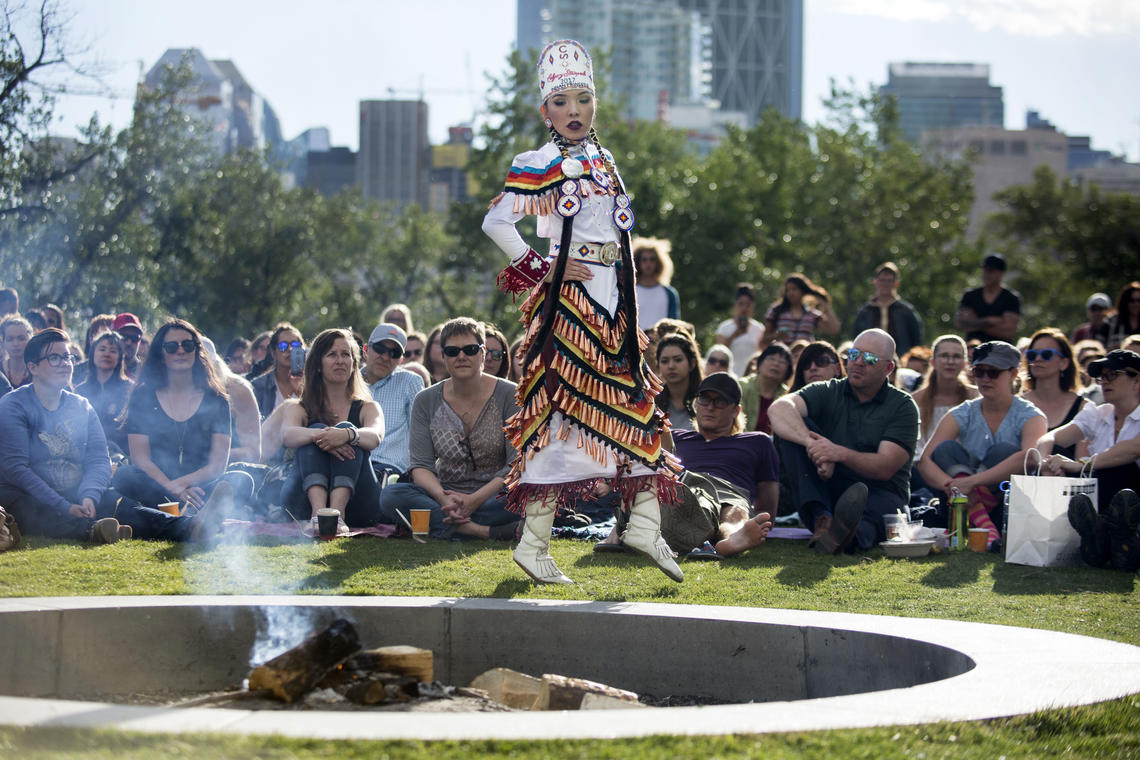June 26, 2017
Kainai elder and astrophysicist share stories and myths of the Blackfoot Skies

Savanna Sparvier, 2017 Calgary Stampede Indian Princess, opens Campfire Chats with a jingle dance.
Colleen De Neve, for the University of Calgary
The confluence of the Bow River and the Elbow River is a sacred place for the Blackfoot people. It was a traditional ceremonial and trading area to many nations where two forces became one — a peaceful place, considered a “no-fly zone” where no archaeological signs of battle exist. It is here, at The Rise on St. Patrick’s Island, where more than 225 Calgarians gathered on National Indigenous Peoples Day for the second annual Campfire Chats to celebrate Indigenous knowledge and listen to the ancestral oral tradition of the Blackfoot people.
Campfire Chats is an annual series hosted by the University of Calgary in partnership with the Calgary Stampede, designed to advance discussions on how we can all work together to continue to build the city we call home. Savanna Sparvier, 2017 Calgary Stampede Indian Princess, opened the event with a jingle dance by the campfire. “Events on National Indigenous Peoples Day such as this serve to educate, inform and build long-lasting community partnerships,” said Warren Connell, CEO of the Calgary Stampede. “The Calgary Stampede is tremendously honoured to have partnered with the University of Calgary for this important event and to gather Calgarians together to celebrate and share the unique culture of Indigenous people.”
Through Kainai Elder Wilton Goodstriker and astronomer and astrophysicist Rob Cardinal, those gathered around the campfire heard the myths of the Blackfoot Skies, the importance of words, storytelling and ways of knowing, and how these connect to Indigenous people’s sense of place in the universe.

Kainai Elder Wilton Goodstriker shares stories of the Indigenous connection to the cosmos.
All things are connected
“There is a sacred kinship between the universe, life and Mother Earth,” said Goodstriker. “When you look at the teepee designs that are found in our lodges, the very top of the teepee acknowledges the universe; the middle part acknowledges life; and the very bottom part of the teepee acknowledges Mother Earth.”
Goodstriker, known as Yellow Spirit Man in his community, captivated the audience as he recounted the Blackfoot peoples’ connection to the cosmos in ancient stories about the origins of the constellations Pleiades and the Big Dipper, which are represented on the southern and northern flaps of the Blackfoot teepees. The two stories tell of orphaned children who were ill-treated and went to live in the sky as celestial beings, and whose movements through the cosmos serve as a reminder to care for our children and of the natural, clockwise flow of the universe.
The only thing we truly own is our story
As Cardinal explained at the event, storytelling is how we find meaning through words. He spoke to the importance of seeking meaning beyond what we’ve broken down scientifically in an effort to know the world.
“Words are very important — they have meaning, and when you put them in a story you share knowledge,” said Cardinal. “We come into this world with nothing and everything else is a gift — life, our families and loved ones, nourishment and education. They were given to you for a reason — to learn from. The only thing we truly own is our story — what it is we choose to do with our lives.”
Cardinal, whose Indigenous name is Star Chief, pursues knowledge of the skies. He discovered two comets and a near-earth asteroid — moving objects within our own solar system — at the university’s Rothney Astrophysical Observatory.
Cosmology is also like a story, Cardinal said — if you rip out the first 50 pages of a book, you won’t understand the full story. The comets and asteroid he discovered are leftovers from the earth’s formation; we come from previous generations of stars, and this is the story that modern science and cosmology are telling. However, the story is not complete — we don’t absolutely know the beginning of it, and there is so much left to be discovered in this story.

Astrophysicist and astronomer Rob Cardinal speaks about the importance of storytelling.
Strengthening the relationship between the Indigenous community and UCalgary
Provost and Vice President (Academic) Dru Marshall highlighted the importance of sharing stories and ensuring UCalgary is a welcoming place not only now, but into the future.
“As we mark Canada 150, it’s incredibly important that we take time to honour the Indigenous voices in our communities, to learn and respect the traditions, culture and ways of knowing woven into the deep heritage of this country,” said Marshall. “In 2017, the Year of Reconciliation and following the calls for action from the Truth and Reconciliation Committee, these are critical stories to tell, and to be heard.”
Over the past year, the university has been developing an Indigenous Strategy that is not only informed by Indigenous communities, but truly shaped by it. The strategy will be launched in the fall and is a true commitment and ongoing, evolving dialogue with Indigenous peoples in our community.
As Goodstriker expressed, society sometimes puts us in a tight little box — but to fully understand all things that surround us, we need to get out of the box to open our spirit, open our eyes, and discover that the world is actually a beautiful place.
The University of Calgary is proud to be part of Canada 150. Our programming highlights the main themes of the Government of Canada’s vision for the 150th anniversary of Confederation: diversity and inclusion, reconciliation from nation to nation with Indigenous people, the environment, and youth. For more information about our Canada 150 activities, visit ucalgary.ca/canada150
